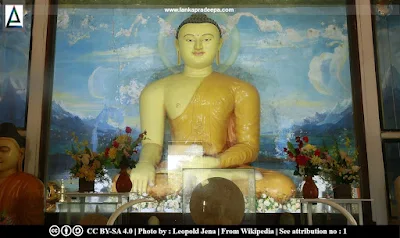
|
Photos showing the vanished Buddha statue |
Samadhi Buddha Statue of the Sri Maha Bodhi Shrine (Sinhala: ශ්රී මහා බෝධි පුදබිමේ සමාධි බුද්ධ ප්රතිමාව) is a vanished stone Buddha statue that was once placed at the Jaya Sri Maha Bodhi Shrine in Maha Viharaya premises in Anuradhapura, Sri Lanka. The statue, apparently similar to the famous Samadhi Statue and Toluvila Statue, has been captured in a few photographs taken in the later 19th century and the early 20th century but, a single piece of evidence to prove its present existence has not been found yet. However, the popular tradition suggests that this statue has been embedded into the large Buddha statue placed in the main shrine of the Bodhi Tree that was reconstructed in the 1910s (Schroeder, 2022).
Photo Evidence

The first clear photograph of the statue was taken in 1895 by Captain J.R. Hogg (1870-1939) in which the statue is depicted half-buried in the ground (Schroeder, 2022). By examining this photograph, the scholar Ulrich von Schroeder assumed it is the only ancient Buddha statue in Sri Lanka seated in the diamond posture (Vajraparyankasana) with both soles pointing upwards and displaying the gesture of touching the earth [(Bhumisparsha-Mudra) Schroeder, 2022]. However, a photograph taken by the British photographer James Dearden Holmes (1873-1937) in the 1920s clearly shows the gesture of the statue is not Bhumisparsha-Mudra but the Dhyana-Mudra (the gesture of meditation with both hands placed on the lap) and the posture is not Vajraparyankasana but Sattvaparyankasana, the noble posture with the right leg placed upon the left leg with only the sole of the right foot visible.
Schroeder further suggested the statue could be a work of the 6th century A.D. carved out of a single slab of dolomite marble (Schroeder, 2022). He also derived the height of the statue as 3.3 m comparing the size of the leaves in the background of the photograph of Hogg (Schroeder, 2022).
Was it Hidden Inside the Modern Statue?

Many believe that the large modern Buddha statue in the main shrine room of the Bodhi Tree was made by plastering and painting the old stone Buddha statue during the reconstruction of the image house in the 1910s. Although the hand gesture of the modern statue and the old stone statue is different, some think that the gesture may have been altered by the people who carried out the later renovation as they believed that the Bhumisparsha-Mudra is the best gesture fit for the main Buddha statue to be placed beside the Jaya Sri Maha Bodhi Tree, the principle Bodhi tree of Sri Lanka as it symbolises Buddha Siddhartha's defeat of Mara (Maravijaya) and subsequent enlightenment under the Bodhi Tree at Bodhgaya in India (Schroeder, 2022). Also, a photograph taken later shows that the right hand of the old stone statue is slightly broken below the elbow.
As is mentioned in Harischandra's book Sithiyam Sahitha Puravidyawa (1927), the renovation work of the dilapidated Bodhi Tree shrine was started by a wealthy devotee named E.R. Gunaratna in 2450 B.E. (1906 A.D.) and finished in 2456 B.E. [(1912) Harischandra, 1927]. According to his description, the seat (1.2 m x 5.1 m x 2.4 m) and the ancient Buddha statue (4.2 m) inside this shrine, which were made of bricks, were also restored during this period (Harischandra, 1927). Therefore, some assume that the large modern Buddha statue in the main shrine room couldn't have been built by covering the old stone statue. Also, the photograph taken by J.D. Holmes indicates that the stone statue was standing on the Bodhi Tree premises even during the 1920s.
Related Posts
Read Also
References
Books, Journal Articles
1) Harischandra, W., 1927. Sithiyam Sahitha Puravidyawa (In Sinhala). pp.66-67.
2) Schroeder, U.V., 2022. The Buddha of the Śrī Mahā Bodhi Shrine at the Mahāvihāra in Anurādhapura. Unpublished manuscript.
Location Map
Dynamic Google Map
Attribution
To Whom
1) Bodhi Tree Image House Buddha 2021 by Leopold Jena is licensed under CC BY-SA 4.0

